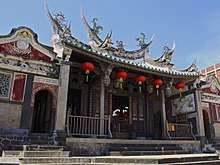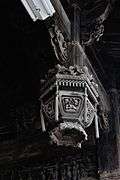Lan Mu
Lan Mu (1872–1943, Chinese: 藍木; pinyin: Lán mù; Pe̍h-ōe-jī: Nâ bo̍k) was from Dabu, Chaozhou of Guangdong Province.[1] He was a famous craftsman of traditional architecture in Taiwan and Penghu during 1916 to 1943.[1] According to the area of his hometown, he might be a Hakkanese, or was able to speak Hakka language.
Lan Mu | |||||||||||||||||||
|---|---|---|---|---|---|---|---|---|---|---|---|---|---|---|---|---|---|---|---|
| Born | |||||||||||||||||||
| Died | |||||||||||||||||||
| Occupation | Craftsman, Architect, Printer | ||||||||||||||||||
| Years active | Taiwan under Japanese rule | ||||||||||||||||||
| Known for | Taiwan Traditional Temple Architecture | ||||||||||||||||||
| Relatives | Lan He (Younger brother) | ||||||||||||||||||
| |||||||||||||||||||
Biography
Lan Mu's parents died in his early years and he went to be a craftsman's apprentice to raise himself and his younger brother Lan He (藍合). Based on his hard work and talent, he became a good wood carving master in Chaozhou.[2]
In 1916, (Taishō 5th year), Lan Mu left his hometown and moved to Penghu with his brother.[2] In 1923, (Taishō 11th year), when Lan Mu was 40 years old (as the East Asian age reckoning), he was surprisingly assigned to be the chief architect of Penghu Mazu Temple repair work in a young age. Three years later, Lan Mu and other craftsmen successfully finished the repair.[1]
Penghu Mazu Temple was the most important work in Lan Mu's career. In addition to Mazu Temple, Lan Mu took part in other repair works, such as Beiji Temple and Beichen Temple, both located at Magong City. Beiji Temple was destroyed by the America Air Force during World War II and Beichen Temple was dismantled and rebuilt in 1981.[1]
Lan Mu also had a printing factory in Penghu.[1] His descendants took it over until the present.
Gallery
Lee Chien-Lang (李乾朗 in Chinese), a Taiwaness traditional architecture investigator, speaks very highly of Lan Mu's works. Moreover, because Lan Mu was from Guangdong, he was different from most of craftsmen in Taiwan main island who were from Fujian. His shape pattern and the decorations had a unique style; he preferred square pillars, and the carving work he did was much finer.[2][3]
- Penghu Mazu Temple





References
- Hsi, Hsueh-Chi (2005). 《續修澎湖縣志.卷14.人物志》 (in Chinese). Penghu County: Penghu County Government. pp. 125–126. ISBN 986001521X.
- Lee, Chien-Lang (2009). 《台灣古建築圖解事典》 (in Chinese). Taipei City: 遠流. p. 162. ISBN 957324957X.
- Lee, Chien-Lang (2002). 《臺灣傳統建築匠藝五輯.匠師訪談專輯》 (in Chinese). Taipei City: 燕樓古建築. p. 76.